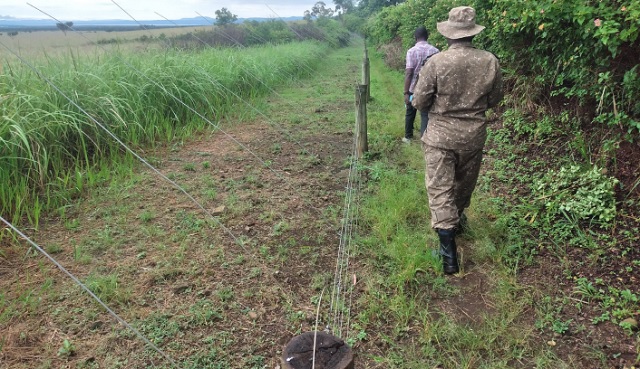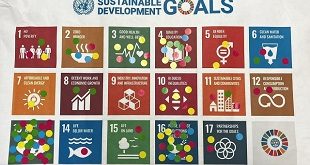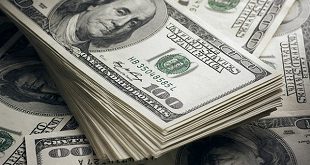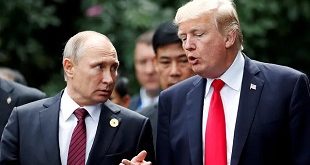
Kampala, Uganda | RONALD MUSOKE | Elephants used to be a nuisance for most residents living in the farming village of Kyenzaza in Kirugu sub-county in Rubirizi, one of the seven districts that border Queen Elizabeth National Park. But, following the construction of an electric fence along the park boundary in late 2021, the attitude of most farmers in this village towards the jumbos has suddenly turned positive. And it is easy to see why, as Ronald Musoke discovered on a recent visit.
Buoyed by recent rains, lush green gardens of sweet potatoes, maize, cassava, onions, soya beans, millet and groundnuts are flourishing in Kyenzaza in Kirugu sub-county in Rubirizi, one of the seven districts that border Queen Elizabeth National Park in Southwestern Uganda.
Seeing thriving gardens just metres away from the park’s boundary is an exciting new development because growing these same crops in this spot 20 months ago would have been a big gamble.
“These days we are okay,” says Flavia Kyomugisha in Runyankore, the local dialect spoken here. Kyomugisha and her daughter, Patience Namanya, were on a cool mid-morning on April 18 weeding their millet garden.
“In the past, elephants would eat everything in our gardens,” she said, “Now, we are sure that when we plant, we will harvest something.”
Kyomugisha who has lived in Kyenzaza for close to 20 years and has over the years observed the feud between man and beast; particularly the elephant, quite closely, says things have changed since the Uganda Wildlife Authority (UWA), the country’s wildlife resources conservation agency, constructed an electric fence to keep wildlife and humans apart.
The structure that separates the gardens of the farmers from a section of the park is an ordinary looking waist-high fence running in a straight line for as far as the human eye can see along a dirt boundary road and behind a thick green shrub hedge.
Along the Kyambura-Kyenzaza-Kagarama section, three-foot round poles run parallel to the park boundary with the communities. The technicians have strung three lines of 2.55mm high tensile wires across the posts.
It is hard to believe this fence is actually effective when it comes to repulsing these huge mammals that are big, tall and powerful. Yet just a few hundred metres away from Kyomugisha’s millet garden, Frank Nkesiga, a youthful subsistence farmer, also sings its praises.
“A lot has changed here,” he too says, “Elephants stopped crossing this side.” He says he has now planted cassava and maize. “We are guaranteed of harvesting whatever we have planted, especially if the weather is good,” he says.
Change in fortune
Before UWA constructed the electric fence, life was not this optimistic for thousands of farmers in these villages which neighbour Queen Elizabeth National Park in the southeast. Big game like elephants and buffaloes used to cross the park boundary which is just a few metres away.

They would then wreak havoc not only in the nearby gardens but would also go as far as seven kilometres inside the neighbouring communities destroying cropland and residential property.
Nkesiga told The Independent that guarding crops was almost a full-time job if one wanted to harvest something at the end of the season. As a coping mechanism, others would even skip the first season (January-July) and concentrate on cotton in the second season. But even then, they would have to guard the cotton gardens in order to harvest something.
“Some of us would invest in renting land and planting materials like seed but we would end up losing all our investment in one single overnight raid by the elephants.” Nkesiga says he would never venture into cassava planting because of elephant raids. He says he and other colleagues who had given up cultivating cassava have resumed growing it.
No more sentry huts
The electric fence has certainly lifted the mood of the majority of farmers who live here. When this reporter first visited this village at the beginning of 2019, the frustration and desperation among residents was palpable.
Makeshift grass-thatched huts dotted the dirt road that runs from Kyambura trading centre along the Kasese-Bushenyi-Mbarara highway into the inner communities.
In Kafuru, residents said the huts were used by sentries to take shelter from the weather elements as they waited to face-off with the marauding elephants. Many subsistence farmers The Independent talked to in Kyenzaza and the nearby Kafuru village said guarding their gardens against elephants was wearing them out. Many said they hated the elephants. This time round, this reporter saw only one hut along the same section of the road.
In Kasese District, similar work has been done on a section of the park which is shared by communities living on its edge. There has also been change in fortune for the residents of Nyaruzigati, another village that neighbours the park in Kahokya sub-county in the nearby Kasese District which has probably the longest border with Queen Elizabeth National Park.
On a blazing afternoon, we met Augustine Baluku, his wife and his three teenage children tilling their farm. When we interrupted them and asked them about the electric fence, it’s Baluku’s wife, Mary Muhindo, who quickly cut in with one short answer: “We now have peace.”
“Before this fence came, we were struggling to keep the elephants from our gardens. Everything had failed,” she said, “We only hope that the government will maintain the fence so that it remains effective to allow us grow our crops of choice.”
Joseph Muhasa, the LC I Chairperson in this village reiterated Mary Muhindo’s sigh of relief. “We used not to sleep in our beds but in the gardens to guard our crops,” he said, “Elephants would leave us almost in destitution.”
In Kasese District, about 38km of electric fence has been laid beginning from Kasese Cobalt Company Ltd (KCCL) while about 20km have been erected in Rubirizi District. In both districts, the electric fence line has been constructed in areas where the conflict between the elephants and people was most prevalent.
Electric fence project
In an attempt to stop elephants from crossing and raiding crops in the adjacent communities, in 2018, UWA partnered with Space for Giants, an international conservation organization that has expertise in doing this work.

Work began with a pilot 10km stretch on the southeastern fringes of Queen Elizabeth National Park from Kyenzaza near Kyambura trading centre which is on the edge of Kyambura Gorge up to Kagarama via the small communities of Kafuru, Nyakahita, Mukari and Mukanyinya in Kyabakara sub-county.
How the electric fence repulses elephants
It is hard to believe this fence is actually effective when it comes to repulsing these huge mammals that are big, tall and powerful. But the fence has actually worked says, Francis Twikirize, the fence supervisor at Kyambura.
To an untrained eye, it is difficult to believe that this short and weak-looking fence can stop a buffalo, let alone an elephant which is big and powerful. The fence is about as tall as the waist of a tall person, yet an elephant can probably be three times taller. But several conservationists The Independent talked to said it is very effective.
Conservation experts who deal with problem animals say electric fences control animals like elephants by giving them a powerful, short, sharp, shock which is unforgettable. The shock received by the animal is a function of the electricity available and total resistance of the circuit. Therefore, an electric fence is both a physical and a psychological barrier, conservationists say.
Its effectiveness in blocking elephants is particularly built around outriggers. When the system is switched on, electricity of up to 9000 volts drawn from solar powered energizers feeds into the wires. When the wires touch an elephant on the soft flesh of its chest or its trunk, the animal is shocked and forced to turn away before it can reach the posts to vandalize the fence and cross into the nearby crop fields.
Although the fence’s voltage is high, the current is low meaning that it cannot electrocute a human being to death. Anyone who touches the wires receives a strong shock but not one that would kill them.
A few disgruntled murmurs
But the electric fence erected in Rubirizi and Kasese is only effective with big game. In the Kyenzaza area, Nkesiga told us how his current problem seems to be the flocks of Crested cranes that sometimes peck out the seed he has sown.
Peterson Bamumpe, a shamba boy who is helping his boss establish a mango farm on about six acres also told The Independent that although the elephants and buffaloes stopped crossing into the farm, his current headache is how to deal with the smaller vervet monkeys and baboons which cannot be deterred by this fence.

“These ones are clever like human beings; they always sneak through the fence and wreak havoc in the garden,” he told The Independent, showing us a young maize cobs that had been eaten by the primates.
“When the boss comes, he says we are eating his mangoes but I can’t eat young mangoes. Right now, we have nothing to eat,” he told The Independent while showing us exhibits of shredded maize cobs that have been ripped apart by baboons and monkeys.
Relief for UWA staff too
Still, the electric fence appears to have brought some collective relief for the staff of the Uganda Wildlife Authority (UWA) who are in charge of park-community relations.
Christopher Masaba, the Senior Warden for Community Conservation in Queen Elizabeth Conservation Area has over the last 22 years had confrontations with people who live in the neighbourhood of game parks like Queen Elizabeth. He talks of being grief-stricken when he witnesses a debilitating injury or even a death visited on a human by a wayward wild animal.
“On a few occasions, you find an animal has gored someone to death and although these animals are for every Ugandan, you are the one in charge. The person is down and dead and, yours are alive back home; it is the worst experience community conservationists face.”
Masaba says such grief always leaves him on the brink of tears. He told The Independent that the electric fence will improve the relations between the park communities and the Uganda Wildlife Authority.

“I hope to see more interactions with happier communities; where we have improved interactions and relationships. I hope this will add positive attitude of the communities towards conservation of the elephants.”
For Sylvest Masereka, the Assistant Warden in charge of problem animal control in Queen Elizabeth National Park, the purpose of all these interventions is to improve community-park relations.
“The moment we achieve this, we would have succeeded; we want people to look at this park as theirs; when they are receiving tangible benefits and maybe we can now focus on tourism,” he told The Independent. “Talking about tourism when one’s crops have been completely destroyed by wild animals, no one would understand you, let alone listen to you.”
Masereka told The Independent that the electric fence has been “almost 100%” effective in the areas it has been erected.
He noted that before UWA adopted the electric fence, the conservation agency had over the years tried several interventions aimed at preventing big game, especially elephants, buffaloes and hippos from crossing into neighbouring communities.
Some of these have included digging trenches, planting Mauritius thorn hedges along park boundaries, guarding, and installing bee hives and chain links. He says these interventions were effective up to a point.
“At UWA, we always look at positive co-existence between human beings and the wildlife. We now have good relations with the communities. They are now happy and they want the electric fence to stay for much longer because they have seen its effectiveness,” Masereka told The Independent in a brief interview at the park headquarters in Katunguru.
“In the past, whenever their crops were destroyed, they would look at every park staff as an enemy; it was as if, it was us chasing the animals into their gardens. These days it feels nice to go out to the communities.”
“I can move out freely to the communities and if it’s maize harvest season, they can even roast for you maize; they say: ‘These are the people who brought us the fence.’ This is a sign that people are happy with the intervention.”
Masereka, a soft-spoken middle-aged man, has worked in conservation for over 25 years and over this time, has witnessed changes in the relations between humans and the wild animals. He says an increase in human population in and around Queen Elizabeth Conservation Area has contributed to the escalation in human-wildlife conflict.
He adds that the park’s unique status of being “a man and biosphere reserve” meaning that human beings are supposed to co-exist with the wildlife has not helped matters.
“Before it became a national park, people were already settled in the fishing villages but they were limited to do certain activities,” says Masereka. “But with increase in human population, demand for resources has shot-up and people have ended up introducing economic activities that were not allowed initially.”
“People have encroached on the wildlife corridors areas where these animals used to thrive. And in the wildlife’s effort to retrace their spaces, the wild animals end up disturbing the human settlements,” Masereka says. He adds that people have moved closer to the park boundaries.

Justus Tusubira, the Uganda Liaison Officer at Space for Giants told The Independent that they have learnt firsthand how human-elephant conflict contributes to communities’ negative attitude towards wildlife.
“In our impact surveys which Space for Giants did in Rubirizi District, we have found that people in the communities have appreciated the impact of the fence,” he says.
People’s attitude towards elephants had also changed with some saying if the government wanted it could increase more elephants in the park as long as they maintain the fence.
“We have learnt that by putting in place efficient human-wildlife conflict mitigation mechanisms, it is the same way like you would promote any project that promotes socio-economic development.”
“For example, by putting the electric fence in areas of Kasese and Rubirizi we have noted that there has been increased investment, increased value of land while people in the neighbouring communities have been able to grow more crops and sell surplus to earn an income.”
He says in their interactions with local village leaders, they used to record many cases of domestic violence. “The men who would spend the cold nights to guard their gardens would leave behind their wives who would be disturbed by other men,” he says adding that there is now reduced domestic violence.
For Christopher Masaba, the Senior Warden for Community Conservation in Queen Elizabeth Conservation Area, the electric fence may not be the silver bullet to problem animals but it carries a bigger percentage in that hope.
“We think that 75% of these cases will reduce in the nearby future to give us opportunity to do other conservation work; where possible we shall either reinforce the fence or introduce other interventions.”
“But from the lessons we have learnt from areas like Nakuru in Kenya, the electric fence works very well if it is very well maintained and therefore, we think the fence will solve for us the biggest problem of the human-wildlife conflict.”
“We think that the relationship between UWA and the communities shall improve greatly,” Masaba told The Independent
 The Independent Uganda: You get the Truth we Pay the Price
The Independent Uganda: You get the Truth we Pay the Price



